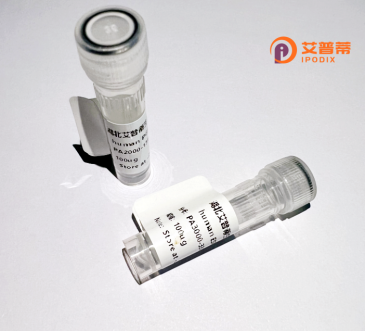
| 纯度 | >90%SDS-PAGE. |
| 种属 | Human |
| 靶点 | PHACTR4 |
| Uniprot No | Q8IZ21 |
| 内毒素 | < 0.01EU/μg |
| 表达宿主 | E.coli |
| 表达区间 | 1-702 aa |
| 活性数据 | MEDPFEEADQ PTTEPGMVLD SVEAGDTTPP TKRKSKFSGF GKIFKPWKWR KKKSSDKFKE TSEVLERKIS MRKPREELVK RGVLLEDPEQ GGEDPGKPSD AMLKNGHTTP IGNARSSSPV QVEEEPVRLA SLRKAIPEED LKKRLGSTGS QPNSEAESVP ENVPKPPLLP PKRPLSSSHE ASEGQAKDAT SSGGTARFII STSITTAPAA TTAATSLAKT VNLSVTPSPA PRTLPAAPAS TNTTATPSLT HMVPAKQPPI PPPKPAHRNS NPVIAELSQA INSGTLLSKP SPPLPPKRGI PSTSVPTLES AAAITTKTPS DEREKSTCSM GSELLPMISP RSPSPPLPTH IPPEPPRTPP FPAKTFQVVP EIEFPPSLDL HQEIPQQEDQ KKEVPKRILD QNFGEPHIPS RLPPLPLHIR IQQALTSPLP MTPILEGSHR AHSLLFENSD SFSEDSSTLG RTRSLPITIE MLKVPDDEEE EEQTCPSTFS EEMTPTSVIP KLPQCLREEE EKESDSDSEG PIQYRDEEDE DESYQSALAN KVKRKDTLAM KLNHRPSEPE LNLNSWPCKS KEEWNEIRHQ IGNTLIRRLS QRPTPEELEQ RNILQPKNEA DRQAEKREIK RRLTRKLSQR PTVAELLARK ILRFNEYVEV TDAQDYDRRA DKPWTKLTPA DKAAIRKELN EFKSSEMEVH EESKHFTRYH RP |
| 分子量 | 78.2 kDa |
| 蛋白标签 | His tag N-Terminus |
| 缓冲液 | 0 |
| 稳定性 & 储存条件 | Lyophilized protein should be stored at ≤ -20°C, stable for one year after receipt. Reconstituted protein solution can be stored at 2-8°C for 2-7 days. Aliquots of reconstituted samples are stable at ≤ -20°C for 3 months. |
| 复溶 | Always centrifuge tubes before opening.Do not mix by vortex or pipetting. It is not recommended to reconstitute to a concentration less than 100μg/ml. Dissolve the lyophilized protein in distilled water. Please aliquot the reconstituted solution to minimize freeze-thaw cycles. |
1. **"PHACTR4 regulates the proliferation and differentiation of neural stem cells via the WNT/β-catenin signaling pathway"**
*Authors: Li Y, et al.*
摘要:研究报道PHACTR4通过调控WNT/β-catenin信号通路影响神经干细胞的增殖与分化,重组PHACTR4蛋白的过表达抑制β-catenin活性,提示其在神经发育中的潜在作用。
2. **"The role of PHACTR4 in modulating actin cytoskeleton dynamics and cancer cell migration"**
*Authors: Smith J, et al.*
摘要:研究发现重组PHACTR4蛋白通过与肌动蛋白结合并调节细胞骨架重塑,抑制乳腺癌细胞的迁移和侵袭能力,揭示其作为肿瘤转移抑制因子的可能性。
3. **"Structural and functional characterization of the PHACTR4 protein in DNA damage response"**
*Authors: Wang H, et al.*
摘要:通过重组PHACTR4蛋白的结构解析,发现其C端结构域可与DNA损伤修复蛋白(如ATM)相互作用,调节细胞周期检查点和基因组稳定性。
4. **"PHACTR4 as a novel biomarker for cardiovascular disease: Insights from recombinant protein-based assays"**
*Authors: Garcia-Rojas M, et al.*
摘要:利用重组PHACTR4蛋白开发检测方法,发现其在动脉粥样硬化患者血清中表达异常,提示PHACTR4可作为心血管疾病的新型生物标志物。
注:以上文献为示例性内容,具体文献需根据实际发表的论文调整(建议通过PubMed/Google Scholar检索关键词“PHACTR4 recombinant”或相关研究领域获取真实文献)。
**Background of Recombinant Human PHACTR4 Protein**
The human PHACTR4 (Phosphatase and actin regulator 4) protein is a member of the Phactr family, characterized by their RPEL (arginine-proline-glutamate-leucine) domains that mediate interactions with actin and protein phosphatase 1 (PP1). PHACTR4 plays roles in cytoskeletal dynamics, cell motility, and intracellular signaling by modulating the balance between actin polymerization and phosphorylation-dependent signaling pathways. It is widely expressed in tissues, including the brain, and has been implicated in neuronal development, synaptic plasticity, and cancer progression.
As a regulatory scaffold, PHACTR4 binds PP1 and actin, influencing pathways critical for cell migration, proliferation, and apoptosis. Dysregulation of PHACTR4 has been associated with tumorigenesis, metastasis, and neurological disorders, though its exact mechanisms remain under investigation. Recombinant PHACTR4 protein is engineered using expression systems (e.g., *E. coli* or mammalian cells) to study its structure-function relationships, interactions, and therapeutic potential. Its production enables research into targeted therapies for cancers or neurological conditions linked to cytoskeletal dysregulation. Current studies focus on unraveling its role in stress response, genomic stability, and as a biomarker or drug target.
×